Immediate action required to limit global warming to 1.5°C

The world is at a crossroads. The decisions we make now can secure a liveable future. We have the tools and know-how required to limit warming. But we must act immediately, and every sector must contribute. The latest IPCC report states that if we take ambitious and concrete action now, we can halve emissions by 2030 - but without immediate and deep emissions reductions across all sectors, limiting global warming to 1.5°C is beyond reach.
GHG Emissions
According to ‘Climate Change 2022: Mitigation of Climate Change’ in the period 2010-2019 average annual global greenhouse gas emissions were at their highest levels in human history, but the rate of growth has slowed. Increasing evidence of climate action gives hope that the world can avert global warming beyond 1.5°C.
- Average annual GHG emissions during 2010-2019 were higher than in any previous decade, but the rate of growth between 2010 and 2019 was lower than that between 2000 and 2009.
- Emissions reductions in CO2 from fossil fuels and industrial processes, due to improvements in energy intensity of GDP and carbon intensity of energy, have been less than emissions increases from rising global activity levels in industry, energy supply, transport, agriculture and buildings.
- Variations in regional, and national per capita emissions partly reflect different development stages, but they also vary widely at similar income levels. The 10% of households with the highest per capita emissions contribute a disproportionately large share of global household GHG emissions. At least 18 countries have sustained GHG emission reductions for longer than 10 years.
GHG Emissions 1990-2019
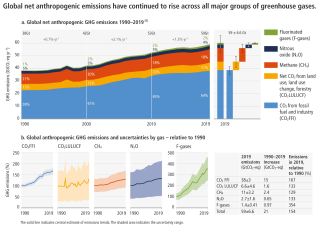
Regional Variations
As outlined, variations in regional, and national per capita emissions partly reflect different development stages, but they also vary widely at similar income levels with the wealthiest households disproportionately contributing to global GHG emissions. Innovation has also lagged in developing countries due to weaker enabling conditions. Digitalisation can enable emission reductions, but can have adverse side-effects unless appropriately governed.
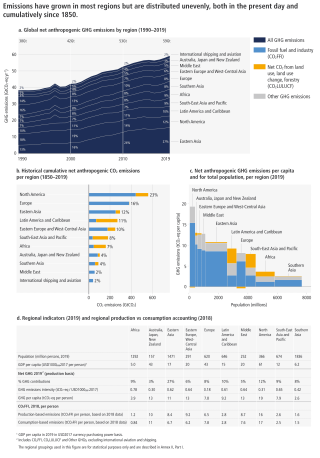
Projected global warming
Global GHG emissions in 2030 associated with the implementation of nationally determined contributions (NDCs) announced prior to COP26 would make it likely that warming will exceed 1.5°C during the 21st century. Without a strengthening of policies beyond those that are implemented by the end of 2020, GHG emissions are projected to rise beyond 2025, leading to a median global warming of 3.2 °C by 2100.
All global modelled pathways that limit warming to 1.5°C involve rapid and deep and in most cases immediate GHG emission reductions in all sectors. Reducing GHG emissions across the full energy sector requires major transitions, including a substantial reduction in overall fossil fuel use, the deployment of low-emission energy sources, switching to alternative energy carriers, and energy efficiency and conservation. The continued installation of unabated fossil fuel infrastructure will ‘lock-in’ GHG emissions.
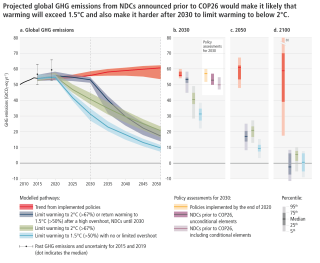
Policies to reduce emissions
According to the report it’s now or never, if we want to limit global warming to 1.5°C. Without immediate and deep emissions reductions across all sectors, it will be impossible. Both tailored policies and comprehensive policies addressing innovation systems have helped overcome the distributional, environmental and social impacts potentially associated with global diffusion of low-emission technologies. There has been a consistent expansion of policies and laws addressing mitigation. This has led to the avoidance of emissions that would otherwise have occurred and increased investment in low-GHG technologies and infrastructure.
Reducing industry emissions will entail coordinated action throughout value chains to promote all mitigation options, including demand management, energy and materials efficiency, circular material flows, as well as abatement technologies and transformational changes in production processes.
Cities can achieve net-zero emissions, but only if emissions are reduced within and outside of their administrative boundaries through supply chains, which will have beneficial cascading effects across other sectors.
Ambitious mitigation efforts for cities will encompass
1) reducing or changing energy and material consumption,
2) electrification, and
3) enhancing carbon uptake and storage in the urban environment.
Well-designed and effectively implemented mitigation interventions, in both new buildings and existing ones if retrofitted, have significant potential to contribute to achieving SDGs in all regions while adapting buildings to future climate.
Electric vehicles powered by low emissions electricity offer the largest decarbonisation potential for land-based transport, on a life cycle basis. Many mitigation strategies in the transport sector would have various co-benefits, including air quality improvements, health benefits, equitable access to transportation services, reduced congestion, and reduced material demand.
Sustainably sourced agricultural and forest products can be used instead of more GHG intensive products in other sectors. Barriers to implementation and trade-offs may result from the impacts of climate change, competing demands on land, conflicts with food security and livelihoods, the complexity of land ownership and management systems, and cultural aspects.
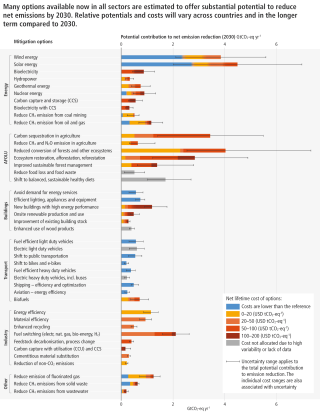
Climate change mitigation and the Sustainable Development Goals
Accelerated and equitable climate action in mitigating and adapting to climate change impacts is critical to sustainable development. Some response options can absorb and store carbon and, at the same time, help communities limit the impacts associated with climate change. For example, in cities, networks of parks and open spaces, wetlands and urban agriculture can reduce flood risk and reduce heat-island effects.
Mitigation in industry can reduce environmental impacts and increase employment and business opportunities. Electrification with renewables and shifts in public transport can enhance health, employment, and equity.
Climate change is the result of more than a century of unsustainable energy and land use, lifestyles and patterns of consumption and production. This report shows how taking action now can move us towards a fairer, more sustainable world.
When is comes to decision-making and implementation, climate governance is most effective when it integrates across multiple policy domains, helps realise synergies and minimize trade-offs, and connects national and sub-national policy-making.
Policy packages that enable innovation and build capacity are better able to support a shift towards equitable low-emission futures than are individual policies
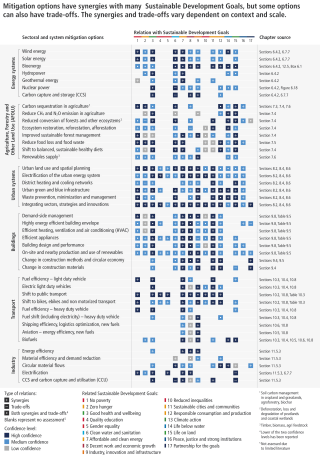
Opportunities
Since 2010, there have been sustained decreases of up to 85% in the costs of solar and wind energy, and batteries. An increasing range of policies and laws have enhanced energy efficiency, reduced rates of deforestation and accelerated the deployment of renewable energy.
There are policies, regulations and market instruments that are proving effective. If these are scaled up and applied more widely and equitably, they can support deep emissions reductions and stimulate innovation.
The report states that there are options in all sectors to at least halve emissions by 2030. Limiting global warming will require major transitions in the energy sector. This will involve
- A substantial reduction in fossil fuel use,
- widespread electrification,
- improved energy efficiency, and
- use of alternative fuels (such as hydrogen).
Having the right policies, infrastructure and technology in place to enable changes to our lifestyles and behaviour can result in a 40-70% reduction in greenhouse gas emissions by 2050. This offers significant untapped potential. The evidence also shows that these lifestyle changes can improve our health and wellbeing.
Closing investment gaps
The report looks beyond technologies and demonstrates that while financial flows are a factor of three to six times lower than levels needed by 2030 to limit warming to below 2°C (3.6°F), there is sufficient global capital and liquidity to close investment gaps. However, it relies on clear signalling from governments and the international community, including a stronger alignment of public sector finance and policy.
Sectoral contributions
Cities and other urban areas also offer significant opportunities for emissions reductions. These can be achieved through lower energy consumption (such as by creating compact, walkable cities), electrification of transport in combination with low-emission energy sources, and enhanced carbon uptake and storage using nature. There are options for established, rapidly growing and new cities.
There are examples of zero energy or zero-carbon buildings in almost all climates. Action in this decade is critical to capture the mitigation potential of buildings. Reducing emissions in industry will involve using materials more efficiently, reusing and recycling products and minimising waste. For basic materials, including steel, building materials and chemicals, low- to zero-greenhouse gas production processes are at their pilot to near-commercial stage. This sector accounts for about a quarter of global emissions. Achieving net zero will be challenging and will require new production processes, low and zero emissions electricity, hydrogen, and, where necessary, carbon capture and storage.
Agriculture, forestry, and other land use can provide large-scale emissions reductions and also remove and store carbon dioxide at scale. However, land cannot compensate for delayed emissions reductions in other sectors. Response options can benefit biodiversity, help us adapt to climate change, and secure livelihoods, food and water, and wood supplies.
It’s now or never, if we want to limit global warming to 1.5°C. Without immediate and deep emissions reductions across all sectors, it will be impossible.